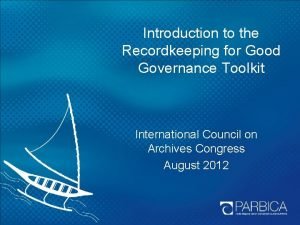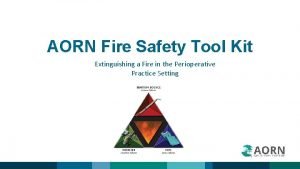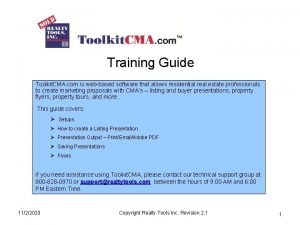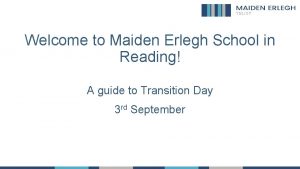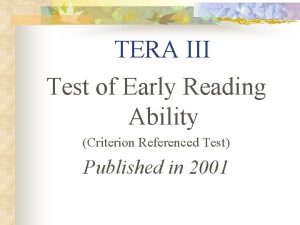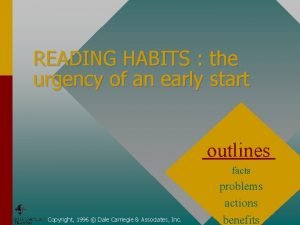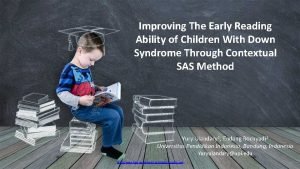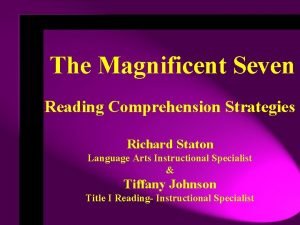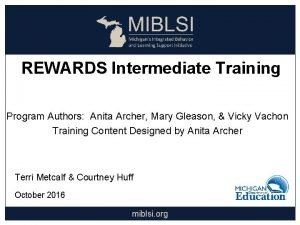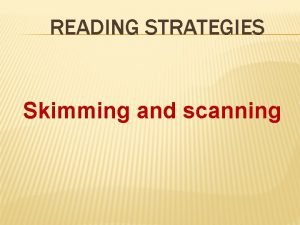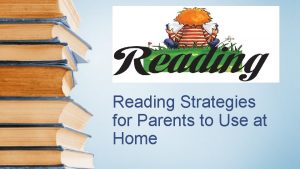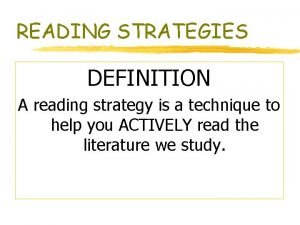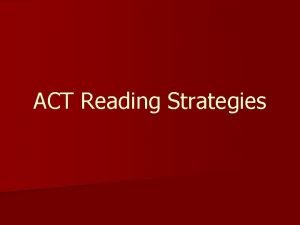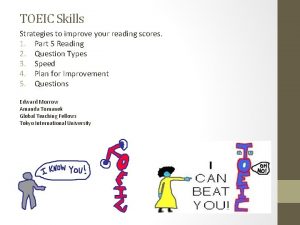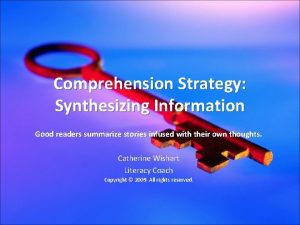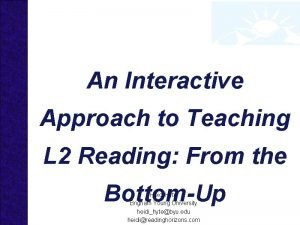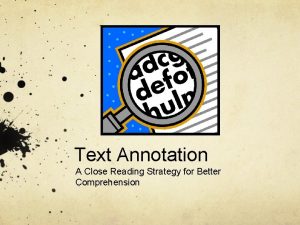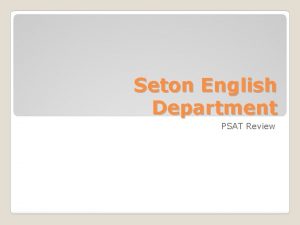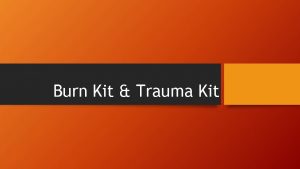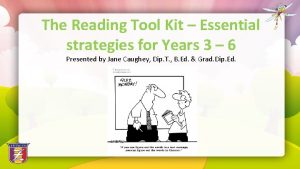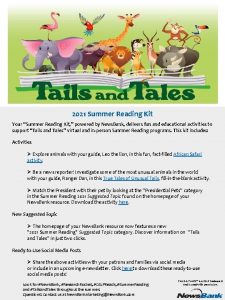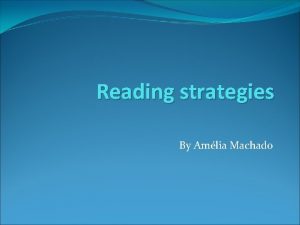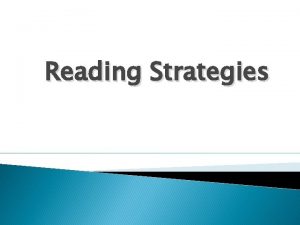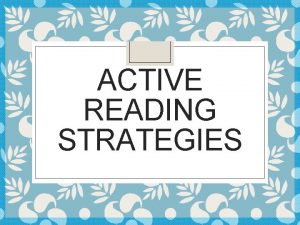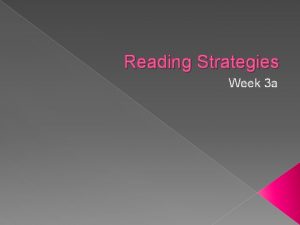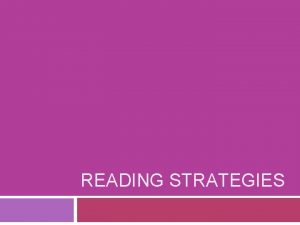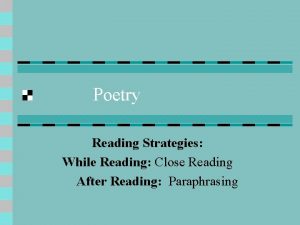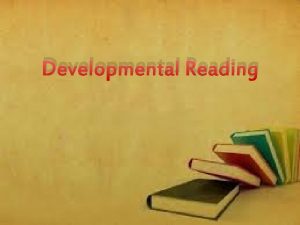The Reading Tool Kit Essential strategies for Early





































- Slides: 37

The Reading Tool Kit – Essential strategies for Early Primary Webinar by Ziptales. com

Teaching students a variety of reading strategies is a top priority for teachers in the early primary years. In this webinar we will explore essential strategies that can be instrumental in helping your students become independent and effective readers. They include: ü Developing phrasing and fluency ü Recognising high frequency words ü Using context clues to predict unknown text ü Monitoring meaning Ziptales offers a webinar devoted to teaching phonics in the early primary years - aptly titled Teaching Phonics. You can locate it via the Webinars link in the Staffroom section of the Teacher Dashboard.

Curriculum Links for Reading Strategies: The Australian Curriculum: English document states that students in Foundation to Year 2 will: • read decodable and predictable texts using phrasing and fluency; • monitor meaning using concepts about print and emerging contextual, semantic, grammatical and phonic knowledge; • use text processing strategies, for example prediction, monitoring meaning, rereading and self-correcting (Literacy Strand: Interpreting, Analysing, Evaluating) • read and write high-frequency words (Language Strand: Phonics and Word Knowledge)

Curriculum Links for Reading Strategies: The New Zealand Curriculum document states that students working at Level 1 will: • use sources of information (meaning, structure, visual and grapho-phonic information) and prior knowledge to make sense of a range of texts; • begin to monitor, self-evaluate, and describe progress. • recognise a large bank of high-frequency and some topic-specific words. (Listening, Reading, Viewing: Processes and Strategies and Language Features)

Developing Phrasing and Fluency Using phrasing during reading means drawing on knowledge of text structures and features to read more fluently. Learning to use phrasing includes developing reading behaviours such as pausing at the right places like at a comma or full stop, and using an appropriate pitch – like saying direct speech as the character would say it. Reading fluency is essentially developed by giving young readers the opportunity to experience success when reading. Effective phrasing and fluency are important strategies as they make reading more enjoyable and meaningful to both the reader and listener.

Modelled Reading: When students listen to fluent readers, they can learn how voice inflection and expression help add meaning to the text. Try to provide opportunities for your students to hear a range of texts read fluently at every opportunity.

Activities: • Use big books or guided reading books. For example, discuss how a comma means a short pause, a full stop means a longer pause (like taking a breath) and the words inside speech marks (or speech bubbles) tell us what a character is saying so we read these words like we think the character might say it. • Ask a range of fluent readers, such as willing parents, older students etc. Assign homework tasks to encourage parents or other family members to read aloud at home, prompting them to use different voice pitches for the characters in the story. • Easy Readers, Storytime stories and Timeless Tales (Ziptales): students listen to models of fluent reading and the use of phrasing. • Orally read a short story using (1) a flat, monotone voice without any pauses; (2) reread it with too much expression; (3) reread the book using appropriate phrasing and expression.

Repeated reading: Repeated reading means asking the child to repeatedly read a familiar text over a period of time. This aims to improve the child’s phrasing and fluency as they become more familiar with the word recognition and flow of the story or rhyme.

Activities: • • Provide opportunities for your students to reread the same text. Begin with nursery rhymes and simple rhyming stories such as the ever popular Hop on Pop (Dr Seuss) or Where is the Green Sheep? (Mem Fox). Easy Readers: After they hear the story, they can practise repeatedly reading a chosen story with the voiceover turned off and use the highlighted text function to assist with phrasing and fluency. Incorporate repeated reading into guided reading lessons using a simple retold version of a text. For example, view the story of Goldilocks and the Three Bears in Storytime, then give students a copy of the retold version from the downloadable worksheet for the Specialised English Reading Lesson (Foundation) module Learning to Read. Reread this simple text each day for four or five days and follow up by completing the worksheets supplied for this story via the Worksheets link. You could also use the actual Storytime and Timeless Tales scripts located via the Staff Room link or the sequencing activities from Worksheet #2 for the Wendy stories and Little Red Riding Hood fairy tale in Storytime and each of the Timeless Tales to use for repeated reading activities.

Adult-child reading: Adult-child reading means that an adult reads a text first to the child, then the child reads it back to them. This presents an ideal opportunity for children to hear reading fluency and phrasing in a one-to-one environment.

Activities: • Promote adult-child reading opportunities at home by sending home simple texts, such as rhymes or short stories, typed up on A 4 paper. Ask the parents/carers to read the text first to the child then have the child read it back to them. Send a different text home each week and compile them in a display folder for safe keeping and rereading opportunities. • Use guided reading lessons as opportunities for students to hear a text first before attempting to read it. The students will get the opportunity to become familiar with the vocabulary in the book and the text structures and features used, which will in turn contribute to phrasing and fluency when it’s their turn to read a section from the book. • Provide opportunities for students to listen to a selected story from the Easy Readers, Storytime stories or Timeless Tales. Ensure the story is suited to the child’s own reading ability. Then have the child read this story back to you, a parent helper, a teacher’s aide or a student teacher.

Choral reading: Choral reading requires students to read along with a fluent reader. In order to do this, the students must be able to see the text that is being read for example, a big book, a poster, an on-screen digital text or photocopied worksheet.

Activities: • • • Provide opportunities for students to read or sing along with a variety of nursery rhymes. Most students are already familiar with them and they are full of rich text that can be explored further e. g. rhyming words, high frequency word use and repeated text e. g. Polly Put the Kettle on, Mary had a Little Lamb, This Little Piggy etc. Students orally read the repeated parts of a simple rhyming text for example, the Easy Reader Short Vowels stories Bad Cat, Let’s Get Wet, Yum Yum, I Wish and Oh No! and the Consonant Blends story Play All Day all have repeated text to suit a choral reading activity. You could also use the repeated text from a familiar story or fairy tale for example in the Storytime fairy tale Three Little Pigs, the students could read along with the wolf’s repeated demands – “Let me come in! Or I’ll huff and I’ll puff and I’ll blow your house in!” and the pigs’ response - “Not by the hair of my chinny chin!” Use simple poems from Rhyme Time for choral reading opportunities e. g. Old Mother Hubbard - Strategy C from the Teacher Strategies Worksheet.

Partner Reading: In partner reading, students take turns to read parts of a text. Different methods for this strategy include matching a fluent reader with a less fluent reader so the stronger reader can assist their partner and provide a model for fluent reading, or pairing up two students who read at the same level.

Activities: • Beginning readers take turns reading a page each from the Easy Readers stories with the voiceover turned off. • Students work with a partner to read the Storytime stories reading different parts of the story e. g. a fluent reader could be the ‘narrator’ and a less fluent reader could be the ‘characters’ by reading only the direct speech in the speech bubbles. • Use your students’ take home readers as tools for partner reading opportunities. Ask the parent/carer to take turns reading with their child perhaps one or two times during the week. NB Take home readers must be appropriate to the child.

Vocabulary Study: Introducing new vocabulary to children before reading a text can help improve reading phrasing and fluency. For example, a story about horse riding might include specialised vocabulary such as stable, stallion, pony, bridle and reins, so if the child can recognise these words before attempting to read the focus text, fluency can be maintained.

Activities: • Scan a text before students read it and record 5 -10 potentially difficult words. Write these words on a chart and identify clues that can help decode them (such as phoneme sounds and segmentation). For example, the Easy Reader story The Little Green Crab: Word purple magical warmth ease bright Letter Sound Clues ‘ur’ like ‘fur’ ‘e’ is silent ‘g’ make ‘j’ sound ‘al’ makes ‘l’ sound ‘ar’ makes ‘or’ ‘ea’ makes long ‘e’ sound Silent ‘e’ at the end ‘i’ makes a long ‘i’ sound ‘gh’ is silent Syllable Clues 2 syllables pur-ple 3 syllables ma-gic-al 1 syllable

Activities: • Vocab strips: They are created by using a strip of paper folded into 3 parts. The word is written in the first section, the meaning of the word in the middle section and a picture to match the word is drawn in the third section. For example the word ‘treasure’ from the Easy Reader Short Vowel story I Wish: treasure Something precious that is worth lots of money.

Readers' Theatre In readers' theatre students use a script based text to rehearse and perform a spoken play for a particular audience. Each student adopts a role, such as the narrator or a certain character, and is required to perform that role when presenting the play. (Shot of Puppet Plays here)

Activities: • View the Puppet Plays and use the Script ideas for Puppet Plays (via the Worksheets link) to write out a script to use as readers’ theatre. • Print the Storytime or Timeless Tales scripts (located via the Staffroom link) to provide opportunities for students to engage in readers’ theatre. • Perform selected Rhyme Time poems as readers’ theatre using the guidelines from the following Teacher Strategies Worksheets: ü Teacher Strategy D for The House that Jack Built ü Teacher Strategy B for Wynken, Bynken and Nod ü Teacher Strategy B for The Owl and the Pussycat

Improving recognition of high-frequency words: Being able to recognise high-frequency words is a core reading strategy imperative for beginning readers to acquire swiftly. The first 100 highfrequency words make up around half of all words read. Another reason why it is important for beginning readers to be skilled in automatically identifying high frequency words is that many of them are not able to be decoded phonetically – ‘many’ is a perfect example with the ‘a’ making an ‘e’ sound.

Activities: • Study the high frequency words that can’t be decoded phonetically e. g. in the word ‘was’ the ‘a’ makes an ‘o’ sound. Locate examples of these words in the classroom environment or when completing worksheets, for example Worksheet #1 for the Easy Reader stories Bad Cat ( was, the, put and under); Is It Fun? (have); I Wish (could, would) and Worksheet #2 for At the Playground (any, more, some, every, one). • After students complete worksheets for the Easy Readers, Storytime stories or Timeless Tales, play a ‘Common word hunt’. Read aloud or display a flashcard of a highfrequency word from the worksheet and students locate and underline the word using different coloured pencils. For example, Worksheet #1 for the Storytime story Wendy and the Genie – was, in, the, she, for, what, and, do, you, when etc.

Activities: • Scan a simple text before reading it and write the high frequency words used in the text on coloured paper dots hidden from view. Students listen to the story. Display the dots and read each word aloud. Reread the story asking students to indicate when they see or hear one of the words on the dots by giving the thumbs up sign. As each word is used, ask one student to select that dot and attach it to a poster with the title of the story written in the middle. Children can make their at he own posters using a on put was in variety of texts. For example, the Easy Reader Short Vowels did the story Bad Cat. BAD CAT what but so and got do

Using Context Clues to predict text Context clues can be very helpful for students when they are attempting to make a reasonable prediction of an unknown word whilst reading. There are three main types of context clues: • semantic clues • syntactic clues • picture support clues.

Picture Support Clues Using pictures to predict unknown words is a strategy used by children in the very early stages of learning to read. Identifying a written word by matching it to a picture is a common layout feature promoted in very simple texts (like alphabet books) and young children rely heavily on the picture to read a particular word. Using picture support clues is very limiting however.

Activities: • Use the pictures on the front cover of a picture book or e-book to predict some of the types of words we might find in that story. For example, the front cover of the Storytime story Wendy and the Pirate shows a beach scene so it is reasonable to suggest that we might find words such as island, beach, holiday and sand. We can also see a picture of a pirate so we could perhaps also find words like treasure, eye patch, ship, wooden leg, hook, sword and map in the story. Write these words down on a whiteboard and tick them off if they are in the book. • Easy Readers: Before listening to the story, turn off the voiceover and search for words in the text that might be difficult to decode phonetically but have picture support to help identify them e. g. Yum, Yum (Short Vowels) e. g. ice-cream, snails, lollies, worms, pumpkin soup, hot chocolate and a cupcake. • View the Easy Readers Short Vowels story Let’s Get Wet. Use Worksheet #2 to discuss what is happening in each picture. Go back through the story and locate individual words that match the pictures e. g. playing, bath, hose, washing, dog, smelly, egg. Use these words to help students write a sentence for each picture.

Semantic Clues Semantic clues or meaning clues, can help a child identify an unknown word when there is little or no picture support. These clues can be found in the same sentence and/or the surrounding sentences and by thinking about how the word is used in the text. For example, when reading a story about going to a party, we might think it would contain words such as birthday, candles, cake, games. So by using context clues, the word ‘birthday’ would be a reasonable prediction for the sentence: There were six candles on the _______ cake.

Activities: • Explore different types of semantic clues that can be used to identify unknown words such as the word’s meaning, synonyms and antonyms for the word and by locating examples of clues from the surrounding text. Create a chart to record this information when reading a new text. For example, the word ‘starving’ from the Storytime story The Three Billy Goats Gruff: Reading Clues Word What is the word? starving Definition What does this word mean? Not having enough food to eat. Synonyms What words mean the same? hungry, famished, underfed, ravenous Antonyms What words mean the opposite? full, satisfied, overfed Examples Can we find clues from the other words or sentences? I’ll eat the first thing that crosses my bridge!

Activities: • Use the ‘Missing Words’ worksheets for the Storytime stories and ‘Which Word? ’ worksheets for the Timeless Tales to provide opportunities for students to practise using context clues to identify an unknown word.

Syntactic Clues Using syntactic clues means applying grammatical knowledge to help correctly identify a word. It is quite a high level skill as the reader needs to use the order of the words to correctly predict what the word might be. For example, in the sentence – I like eating ______ , the missing word must be a noun (such as bananas) as a verb (like bend) or an adjective (like brown) wouldn’t make sense.

Activities: • Remove some of the words from sentences in a simple text for students to predict what the word might be according to its grammatical function. For example the Easy Readers Consonant Blends story At the Playground – At the playground, there’s a big, steep ______(noun); At the playground there’s a ______, _______, slide (adjectives); So I tried to be brave and ____ up for a ride (verb). • View the Specialised English Writing Lessons What is a Sentence? (Foundation) and What is Grammar? What are Nouns? and What are Verbs? (Years 1 & 2) to explore the use of appropriate grammar in sentence construction. • Use grammar related Storytime worksheets to explore how different types of words are used in a sentence. For example Worksheet #1 for The Three Little Pigs, The Three Billy Goats Gruff , Goldilocks and Snow White (Timeless Tales) all study adjectives and Worksheet #3 for Goldilocks and Little Red Riding Hood look at nouns and verbs.

Monitoring meaning requires a student to check their understanding of a text before, during and after reading. This monitoring can be performed by using some specific reading behaviours such as: ü using prior knowledge – drawing on what is already known to better understand a text ü self-correcting – going back to correct reading errors ü cross-checking – using a combination of phonics knowledge, high frequency word recognition and context clues to understand text ü re-reading – scanning back through the text to consolidate meaning

Activities: • Discuss with students effective reading behaviours by exploring some of the things they can do to help them understand a text: Before reading – Look at the front cover. Ask: What type of text is this? What do I think it will be about? What kinds of words might I find in this book? During Reading – Read each word carefully. Go back and reread the words if a mistake is made. Try to predict unknown words using the clues around the word, sounding it out or chunking the word. Ask: Does this story make sense? After reading: Think about what the story is about. Ask: Do I understand this story? Do I need to find out the meanings of any words I didn’t know? • View the Specialised English Reading Lessons Learning to Read (Foundation) and Becoming a Better Reader (Years 1 & 2) to explore monitoring strategies.

Activities: • Students trace around their hand write a monitoring strategy in each finger shape, for example: 1. Stop and reread 2. Go back to fix up mistakes 3. Follow the words carefully 4. Check that it makes sense 5. Use what I already know Cut out the hand shape and encourage students to use these behaviours when reading new texts.

Conclusion Equipping young readers with the tools they require to experience success in reading is an important and rewarding responsibility. Encouraging your students to use the reading strategies in this webinar will assist them to become independent and effective readers.

Questions and Answers…

If you are not a subscriber yet, register for a 30 day free trial of Ziptales at www. ziptales. com
 While reading activities
While reading activities Kit bond strategies
Kit bond strategies Essential non essential fatty acids
Essential non essential fatty acids 4 pillars of sanctuary model
4 pillars of sanctuary model Aorn fire safety
Aorn fire safety Corporate governance tool kit
Corporate governance tool kit Aorn fire safety
Aorn fire safety Workforce tool set
Workforce tool set Toolkitcma support
Toolkitcma support Cfit alar
Cfit alar Tool kit learning walk
Tool kit learning walk Problem severity score
Problem severity score Ecolab housekeeping tool kit
Ecolab housekeeping tool kit Objectives of essential newborn care
Objectives of essential newborn care Cues questions and advance organizers
Cues questions and advance organizers Early cpr and early defibrillation can: *
Early cpr and early defibrillation can: * Maiden early school reading
Maiden early school reading Test of early reading ability
Test of early reading ability Han emperors
Han emperors Reading early start
Reading early start Test of early reading ability
Test of early reading ability Seven comprehension strategies
Seven comprehension strategies Rewards anita archer
Rewards anita archer What is skimming technique
What is skimming technique Reading strategies for parents to use at home
Reading strategies for parents to use at home Meaning of reading strategy
Meaning of reading strategy What are types of reading
What are types of reading Super 6 comprehension strategies
Super 6 comprehension strategies Nonfiction reading strategies
Nonfiction reading strategies How to develop reading skills in students
How to develop reading skills in students Six active reading strategies
Six active reading strategies Act reading strategies
Act reading strategies Taking the toeic skills and strategies 1
Taking the toeic skills and strategies 1 Poetry reading strategies
Poetry reading strategies Synthesizing information allows a reader to
Synthesizing information allows a reader to Top down process of reading
Top down process of reading Annotating reading strategies
Annotating reading strategies Psat reading strategies
Psat reading strategies





